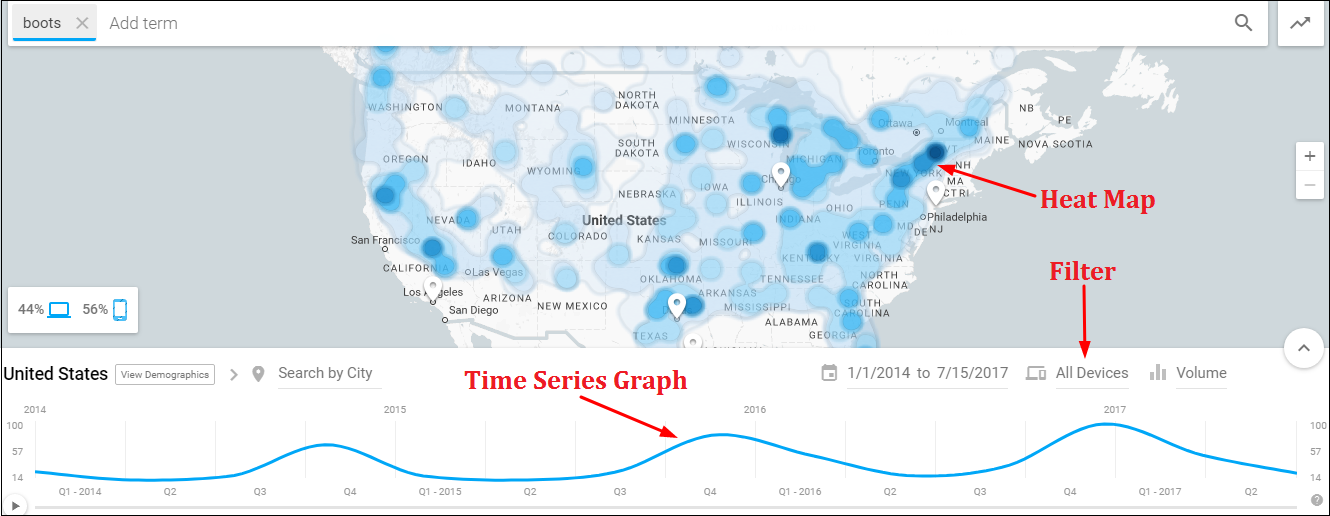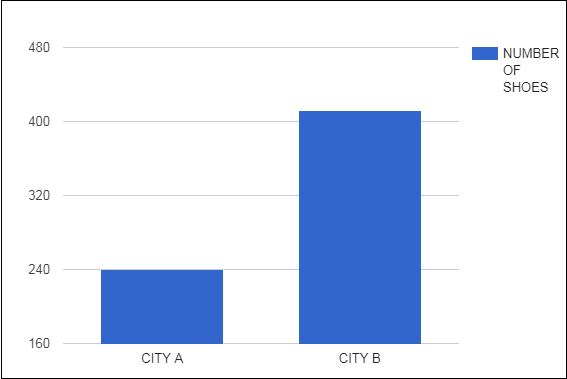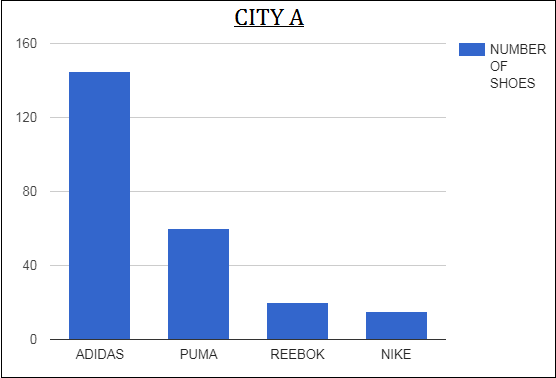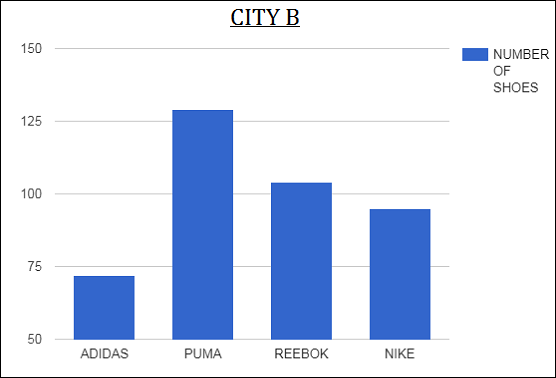Released at WSJDLive, October 20, 2015, Google launched an exceptional tool called Shopping Insights in beta phase. The tool is meant to show retailers and other businesses statistical data about what and how much customers are searching for a specific product in their cities. Google Shopping Insights is helpful in showing the top searched and trending products on the city level for a particular month.
So What Exactly is Google Shopping Insights
Google Shopping Insights, is a service aimed to help retailers understand the way consumers shop for different products via Google. Introduced 2 years back, the feature was first made available in the beta version with next significant update in November 2016. It gives you an edge over exploring details about specific products trending on Google.com, their trend track record, comparative analysis based on regions, and much more.
Using the feature, retailers can get to know how customers shop for products using their devices and PCs on Google. At present, the majority of people search online, still, most of them buy products from physical stores. What makes Shopping Insights interesting for retailers is the way it shows them consumers’ preferences and mindshare for different products on the basis of the city, state, or country.
Google Shopping Insights Vs AdWords Keyword Planner
Well, of course, there is already the AdWords Keyword Planner which helps you find current search trends and new keywords, but Shopping Insights goes one step further from finding out the latest trends only…it offers the capability to understand consumer’s shopping trends in detail on a city-by-city level with a lot more useful features. Also, it is more of a decision-making tool to adjust your strategy than a concrete AdWords helper.
Main features of Shopping Insights
As already said above, Google Shopping Insights is meant to serve retailers with proper information on the trending and popular products searched and bought by customers using Google as the medium.

There are three main categories:
Featured Stories
It shows the featured stories about different niche and products, services, etc on the basis of their popularity and search.
Top Products
This category deals with the top 10 searched products on Google. The tool ranks products which have the highest query volume for a specific month. The top products are decided as the top 10 products with the highest search volumes for a certain month. This list is then displayed in descending order.
Trending Products
This is where comparative analysis is offered. Trending products are calculated with a comparison of search volumes for the particular month against the previous month. This category shows 5 top and the least trending products in a somewhat graphical way to show their performance over the month in consideration. It also shows the estimated growth or downfall in the popularity or demand of that specific product over that month and is sorted according to the highest volume of change.
Other than these visible features, the tool has much more interesting stuff hiding under its hood. Here’s the roundup:

Heat Map
This indicates a product’s popularity in a particular time period throughout different regions. The darker shades on the map mean higher consumer interest in that item(s). One thing to note here is that the data displayed on these heat maps is relative to a specific city with the highest level of interest (max 100). When you zoom, you will be able to view info on a micro level for all the listed cities, states, and regions. You can zoom until each city becomes a visible circle. When you hover on a circle, it will display you the interest level in that city as compared to the city with the highest interest.
Data Filter
If you’d like, you can even filter the data on the basis of a device. This will let you compare and analyze the interest ratio on smartphones against laptops or desktops. What’s more, you can additionally compare multiple products. The entire data is normalized in comparison to the highest point for the specific chart in a review.
Time Series Graph
You can also view the time series graph to get an idea of consumer’s interest in an item over particular time periods. This data is shown in form of percentage with the highest point on the graph as 100 (as already said).
How Google Shopping Insights Work
- Using Shopping Insights is quite easy. Google provides data input to Insights tool on the basis of search queries made by users/customers through Google.com as well as Google.com/shopping.
- The data collected is then aggregated, emphasizing on a specific product on the basis of queries (extensive samples of searches for that particular item).
- At the same time, it factors the overall probability of people searching for the same item using different keywords or phrases.
The current version of Shopping Insights lets you conduct the search based on their name or brand name. One thing to note here is that the search giant is more concerned about customers’ interest levels in the specific products rather than the keywords. Hence, a single keyword is used to represent every product or brand name.
The tool is all centered around retailers having physical stores as stats show that most of the goods are purchased offline (from the stores). This can help retailers understand the taste and preferences of customers trending for that particular month on the city level.
Use from Retailer’s’ Perspective
So you must be thinking now how exactly is this new tool important for business owners. Right? Well, it’s more like Google Trends for retailers. The data offered by Shopping Insights serves businesses with the ability to overview and understand consumers’ shopping patterns and trends in specific locales. Using this info-rich statistical data, they can better analyze and generate suitable models, strategies, and campaign concepts keeping in mind their target audience.
To sum it up, Google Shopping Insights is a great way to understand the local shopping trends of customers and performance of specific products over local or other regions (as offered by Google).
Let’s Take an Example
Situation I: Without Shopping Insights
- Suppose you have a shoe retailing business in a City A and B, selling shoes of different brands like Adidas, Puma, Reebok, and more.
- You have been selling your stuff like always and don’t have any idea on what the target audience is actually after.
- Your sale for the month of June:
- City A – 240 pairs of shoe
- City B – 412 pairs

- You can’t differentiate why there’s a gap between sales despite similar infra of shops and all other factors being constant. This leads to a problem in designing new strategies to buck up the sales.
Situation II: Using Shopping Insights
- Now let’s suppose you use Shopping Insights to get data about the trending shoes in both the cities.
- The data from the new tool will show you top searched branded shoes in both the cities (if they are listed) by customers
- Search volume in City A – 12780, number of shoe pairs sold – 240 (Adidas – 145, Puma – 60, Reebok – 20, Nike – 15)

– While the same for City B is 23467, number of shoe pairs sold – 412 (Adidas 72, Puma – 129, Reebok – 104, Nike – 95)

- Using this data, you will get to know which brand is leading in which city (Adidas in City A | Puma and Reebok in City B) for June and you can plan your stock accordingly.
- When you know what your target customers are looking for and you have that in your stock. Even the online retailers can search for local product hotspots so that they can accordingly adjust their strategy which will eventually invite more sales, hence more profit.
The tool is additionally a bonus for businesses who will welcome the resourceful insights as offered by the data to know the product’s popularity and trends. This info can then be used by a wise product marketer to target AdWords.
Use From Users’ Perspective
It is not that the tool is only for the businesses and retailers. Shopping Insights is not equally but pretty helpful for customers as well. If you are someone who likes to stay with the latest trends, you can easily find out what specific product is leading in your city.
Let’s take an example
- For instance, you want to buy a phone yet you are not sure which one’s best.
- You just look up to Google Shopping Insights and enter phones.
- You get a statistical estimate of the top trending phones as well as the least trending ones.
- You simply go through the trending ones and make your decision (what’s most people are loving means it’s probably the better choice…isn’t so!) or at least you get a clear idea.
That’s it!
What’s New!
Soon after its release, Google added more features and data to its tool. The most recent update is Shopping Insights v4.2, which was released last year on November 17. The latest version has new interest-based visualization, availability of demographic and national level data, as well as user feedback interface. Additional features were also added, including an option to explore trending products for preceding month, a graphic representation of split between desktop and mobiles, along with a streamlined data picker.
How to Use It
We won’t make it long. Google has made it easy for people to familiarize themselves with the tool. You can visit the official link to get started –
https://shopping.thinkwithgoogle.com/
Google’s Official demo video –
Drawbacks and Limitations of Shopping Insights – Maybe Not a Jack-of-all-Trades!
Like every other thing, Google Shopping Insights is no exception from flaws and limitations. The main issues with the tool are:
- For now, the data provided by the tool is only about search queries made from April 1, 2014.
- The data offered is available only for US-based markets.
- Even the city level data is limited to 16000 US cities.
- You can only search and analyze the products/services as allowed under Google Shopping Policy.
- The available data is rated on a 0-100 scale. The reason behind this is to allow a simpler comparative analysis. Yet, the drawback is that the numbers are only estimates and do not reflect the actual search volume.
- The Shopping Insights tool is no help to the product merchants of items that are regarded under the moderate niche but are still searched and requested by customers.
So What’s Next?
Google Shopping Insights is a great and beautifully designed tool for understanding shopping trends.
For now, everyone has been treating the tool for retailers and suppliers. Interestingly, Shopping Insights is a boon for e-commerce as it opens a new world of opportunity for e-commerce channels to come up with productive and successful strategies. Although limited, it’s a great tool for understanding latest trends for different products( like Posts on Google ) on the city level. The tool stresses basically on retailers, e-commerce, and comparison of local shopping trends.
Google said the tool is a gift for offline retailers, however, it’s significantly useful for online-only retailers as well in redesigning their campaigns on product hotspots. The only big catch in the tool is its inability to serve sellers who offer products that are listed relatively niche yet are still demanded by many users. These products include gifts with limited editions for festivals or special occasions.
All in all, the tool CAN do MUCH MORE yet it all depends on Google that how much it improves it in future. Until then, Shopping Insights can offer businesses a clear sense of what their target audience is searching for BUT it’s still unable to predict what is ACTUALLY being sold.
Although Google Shopping insights will help retailers to see the existing shopping trends, they will still need to rely on their personal analysis and estimates for real data.
Drawbacks and Limitations of Shopping Insights – Maybe Not a Jack-of-all-Trades!
Like every other thing, Google Shopping Insights is no exception from flaws and limitations. The main issues with the tool are:
- For now, the data provided by the tool is only about search queries made from April 1, 2014.
- The data offered is available only for US-based markets.
- Even the city level data is limited to 16000 US cities.
- You can only search and analyze the products/services as allowed under Google Shopping Policy.
- The available data is rated on a 0-100 scale. The reason behind this is to allow a simpler comparative analysis. Yet, the drawback is that the numbers are only estimates and do not reflect the actual search volume.
- The Shopping Insights tool is no help to the product merchants of items that are regarded under the moderate niche but are still searched and requested by customers.
So What’s Next?
Google Shopping Insights is a great and beautifully designed tool for understanding shopping trends.
For now, everyone has been treating the tool for retailers and suppliers. Interestingly, Shopping Insights is a boon for e-commerce as it opens a new world of opportunity for e-commerce channels to come up with productive and successful strategies. Although limited, it’s a great tool for understanding latest trends for different products( like Posts on Google ) on the city level. The tool stresses basically on retailers, e-commerce, and comparison of local shopping trends.
Google said the tool is a gift for offline retailers, however, it’s significantly useful for online-only retailers as well in redesigning their campaigns on product hotspots. The only big catch in the tool is its inability to serve sellers who offer products that are listed relatively niche yet are still demanded by many users. These products include gifts with limited editions for festivals or special occasions.
All in all, the tool CAN do MUCH MORE yet it all depends on Google that how much it improves it in future. Until then, Shopping Insights can offer businesses a clear sense of what their target audience is searching for BUT it’s still unable to predict what is ACTUALLY being sold.
Although Google Shopping insights will help retailers to see the existing shopping trends, they will still need to rely on their personal analysis and estimates for real data.
Drawbacks and Limitations of Shopping Insights – Maybe Not a Jack-of-all-Trades!
Like every other thing, Google Shopping Insights is no exception from flaws and limitations. The main issues with the tool are:
- For now, the data provided by the tool is only about search queries made from April 1, 2014.
- The data offered is available only for US-based markets.
- Even the city level data is limited to 16000 US cities.
- You can only search and analyze the products/services as allowed under Google Shopping Policy.
- The available data is rated on a 0-100 scale. The reason behind this is to allow a simpler comparative analysis. Yet, the drawback is that the numbers are only estimates and do not reflect the actual search volume.
- The Shopping Insights tool is no help to the product merchants of items that are regarded under the moderate niche but are still searched and requested by customers.
So What’s Next?
Google Shopping Insights is a great and beautifully designed tool for understanding shopping trends.
For now, everyone has been treating the tool for retailers and suppliers. Interestingly, Shopping Insights is a boon for e-commerce as it opens a new world of opportunity for e-commerce channels to come up with productive and successful strategies. Although limited, it’s a great tool for understanding latest trends for different products( like Posts on Google ) on the city level. The tool stresses basically on retailers, e-commerce, and comparison of local shopping trends.
Google said the tool is a gift for offline retailers, however, it’s significantly useful for online-only retailers as well in redesigning their campaigns on product hotspots. The only big catch in the tool is its inability to serve sellers who offer products that are listed relatively niche yet are still demanded by many users. These products include gifts with limited editions for festivals or special occasions.
All in all, the tool CAN do MUCH MORE yet it all depends on Google that how much it improves it in future. Until then, Shopping Insights can offer businesses a clear sense of what their target audience is searching for BUT it’s still unable to predict what is ACTUALLY being sold.
Although Google Shopping insights will help retailers to see the existing shopping trends, they will still need to rely on their personal analysis and estimates for real data.
